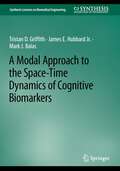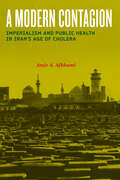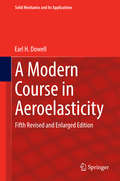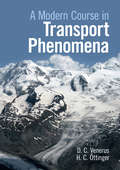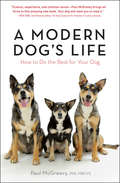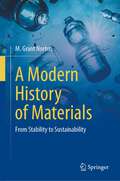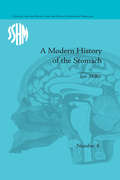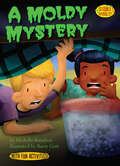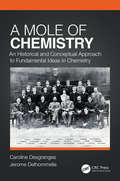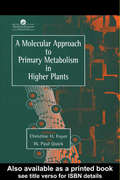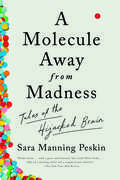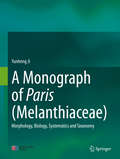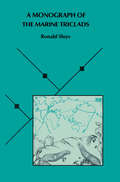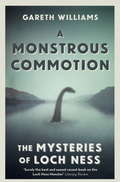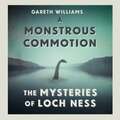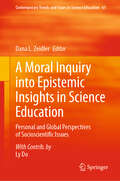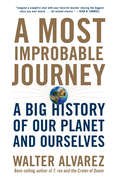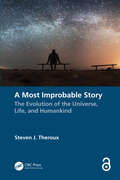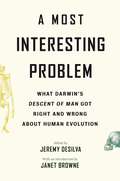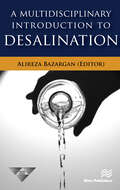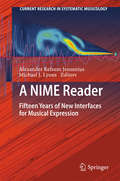- Table View
- List View
A Modal Approach to the Space-Time Dynamics of Cognitive Biomarkers (Synthesis Lectures on Biomedical Engineering)
by Tristan D. Griffith James E. Hubbard Jr. Mark J. BalasThis book develops and details a rigorous, canonical modeling approach for analyzing spatio-temporal brain wave dynamics. The nonlinear, nonstationary behavior of brain wave measures and general uncertainty associated with the brain makes it difficult to apply modern system identification techniques to such systems. While there is a substantial amount of literature on the use of stationary analyses for brain waves, relatively less work has considered real-time estimation and imaging of brain waves from noninvasive measurements. This book addresses the issue of modeling and imaging brain waves and biomarkers generally, treating the nonlinear and nonstationary dynamics in near real-time. Using a modal state-space formulation leads to intuitive, physically significant models which are used for analysis and diagnosis.A Modal Approach to the Space-Time Dynamics of Cognitive Biomarkers provides a much-needed reference for practicing researchers in biomarker modeling leveraging the lens of engineering dynamics.
A Modern Contagion: Imperialism and Public Health in Iran's Age of Cholera
by Amir A. AfkhamiHow deadly cholera pandemics transformed modern Iran.Pandemic cholera reached Iran for the first of many times in 1821, assisted by Britain's territorial expansion and growing commercial pursuits. The revival of Iran's trade arteries after six decades of intermittent civil war, fractured rule, and isolation allowed the epidemic to spread inland and assume national proportions. In A Modern Contagion, Amir A. Afkhami argues that the disease had a profound influence on the development of modern Iran, steering the country's social, economic, and political currents.Drawing on archival documents from Iranian, European, and American sources, Afkhami provides a comprehensive overview of pandemic cholera in Iran from the early nineteenth century to the First World War. Linking the intensity of Iran's cholera outbreaks to the country's particular sociobiological vulnerabilities, he demonstrates that local, national, and international forces in Iran helped structure the region's susceptibility to the epidemics. He also explains how Iran's cholera outbreaks drove the adoption of new paradigms in medicine, helped transform Iranian views of government, and caused enduring institutional changes during a critical period in the country's modern development.Cholera played an important role in Iran's globalization and diplomacy, influencing everything from military engagements and boundary negotiations to Russia and Britain's imperial rivalry in the Middle East. Remedying an important deficit in the historiography of medicine, public health, and the Middle East, A Modern Contagion increases our understanding of ongoing sociopolitical challenges in Iran and the rest of the Islamic world.
A Modern Course in Aeroelasticity: Fifth Revised and Enlarged Edition (Solid Mechanics and Its Applications #217)
by Earl H. DowellThis book cover the basics of aeroelasticity or the dynamics of fluid-structure interaction. While the field began in response to the rapid development of aviation, it has now expanded into many branches of engineering and scientific disciplines and treat physical phenomena from aerospace engineering, bioengineering, civil engineering, and mechanical engineering in addition to drawing the attention of mathematicians and physicists. The basic questions addressed are dynamic stability and response of fluid structural systems as revealed by both linear and nonlinear mathematical models and correlation with experiment. The use of scaled models and full scale experiments and tests play a key role where theory is not considered sufficiently reliable. In this new edition the more recent literature on nonlinear aeroelasticity has been brought up to date and the opportunity has been taken to correct the inevitable typographical errors that the authors and our readers have found to date. The early chapters of this book may be used for a first course in aeroelasticity taught at the senior undergraduate or early graduate level and the later chapters may serve as the basis for a more advanced course, a graduate research seminar or as reference to provide an entree to the current research literature.
A Modern Course in Statistical Physics
by Linda E. Reichl"A Modern Course in Statistical Physics" is a textbook that illustrates the foundations of equilibrium and non-equilibrium statistical physics, and the universal nature of thermodynamic processes, from the point of view of contemporary research problems. The book treats such diverse topics as the microscopic theory of critical phenomena, superfluid dynamics, quantum conductance, light scattering, transport processes, and dissipative structures, all in the framework of the foundations of statistical physics and thermodynamics. It shows the quantum origins of problems in classical statistical physics. One focus of the book is fluctuations that occur due to the discrete nature of matter, a topic of growing importance for nanometer scale physics and biophysics. Another focus concerns classical and quantum phase transitions, in both monatomic and mixed particle systems. This fourth edition extends the range of topics considered to include, for example, entropic forces, electrochemical processes in biological systems and batteries, adsorption processes in biological systems, diamagnetism, the theory of Bose-Einstein condensation, memory effects in Brownian motion, the hydrodynamics of binary mixtures. A set of exercises and problems is to be found at the end of each chapter and, in addition, solutions to a subset of the problems is provided. The appendices cover Exact Differentials, Ergodicity, Number Representation, Scattering Theory, and also a short course on Probability.
A Modern Course in Transport Phenomena
by Hans Christian Öttinger David C. VenerusThis advanced text presents a unique approach to studying transport phenomena. Bringing together concepts from both chemical engineering and physics, it makes extensive use of nonequilibrium thermodynamics, discusses kinetic theory, and sets out the tools needed to describe the physics of interfaces and boundaries. More traditional topics such as diffusive and convective transport of momentum, energy and mass are also covered. <P><P>This is an ideal text for advanced courses in transport phenomena, and for researchers looking to expand their knowledge of the subject. The book also includes: • Novel applications such as complex fluids, transport at interfaces and biological systems, • Approximately 250 exercises with solutions (included separately) designed to enhance understanding and reinforce key concepts, • End-of-chapter summaries. <P> Presents a unique approach to studying transport phenomena.<P> Mathematically rigorous, yet uses an easy-to-follow structure.<P> Includes numerous homework exercises and solutions.
A Modern Dog's Life: How to Do the Best for Your Dog
by Paul McGreevy PhD, MRCVSAn animal behavior expert “combines sensible information with charming wit [in] an entertaining guide for new and veteran dog owners” (Ken Foster, author of The Dogs Who Found Me). What do dogs value? Why do they get so excited by their daily walks? And why do canines of different breeds have different needs? Veterinarian and professor of animal behavior Dr. Paul McGreevy answers these questions and many more, explaining what life is like from a pooch’s perspective—including a special section about dogs and city living. Filled with humor and memorable characters (including “Uncle Wolf” and “Feral Cheryl”), this guide offers: Insights from recent studies on how dogs see, smell, and experience the worldExplanations of canine behavior, accompanied with over forty action photosTips on everything from petting them to calming them at the vet’sUser-friendly training techniques that build skills gradually and keep your pet motivated Dr. McGreevy offers an exciting new approach to training a dog: By acting as a “life coach”—rather than an “alpha dog” or “parent”—and by looking at the process as a fun opportunity for you and your pet to grow closer and learn new skills, you can greatly improve your dog’s quality of life, and teach good behavior at the same time. “Science, experience, and common sense . . .Your dog will want you to read it.” —Mark Evans, chief veterinary adviser, Royal Society for the Prevention of Cruelty to Animals
A Modern Herbal
by Alys FowlerTHE BEST GARDENING BOOKS OF THE YEAR - GARDENS ILLUSTRATED'Informative and enthusiastic' i PaperPLANT-BASED MEDICINE FOR A CALMER, HEALTHIER LIFE It's easy to turn to the pharmacy when we're stressed, sick or feeling under the weather, but what if you turned to your garden instead?In this accessible and easy to use manual, horticultural expert, former Gardener's World presenter and Guardian columnist, Alys Fowler, shows how to take control of your health by adopting a more natural lifestyle. For thousands of years, people who had no access to clinical medicine knew how to boost their well-being by using the ingredients they found in plants. Herbs are the people's medicine; often freely available and abundant, they are ready and waiting to be plucked from around you to soothe and heal your body and mind. With guides for how to use and grow over 100 herbs - for example how to use fennel for indigestion, camomile for anxiety and nettle for hayfever - you'll soon be heading into the garden, rather than opening the medicine cabinet. Offering a fusion of botanical, practical, cultural and historical information, A Modern Herbal reveals how common herbs are the simple, cleansing way to better health and happiness.AS SEEN IN THE GUARDIAN'An important and accessible herbal for the 21st century . . . For anyone delving into herbs for the first time or those who want to broaden their herbal repertoire in the garden and home, this book is much needed' Gardens Illustrated
A Modern History of Materials: From Stability to Sustainability
by M. Grant NortonWhat could the ancient Egyptians tell us about 3D printing? How can we make lithium-ion batteries greener and more sustainable? Which materials will form the heart of future quantum computers?Plastic films, glass optical fibers, silicon crystals, and more — this book is about the history of the materials that have rapidly transformed our society over the last century and their role in the major global challenges of the future. From metal alloys ushering in a new age of industry to advanced materials laying the atomic brickwork of the Digital Revolution, the book examines the societal impact of the modern materials revolution through the twin lenses of stability and sustainability.Why aren’t maglev trains mainstream? Whatever happened to graphene and carbon nanotubes? The book also looks at the unmet promises of some of the most exciting — and hyped — technologies in recent decades — superconductivity and nanotechnology. The final chapter reviews our history of materials usage, the increasing demand for many critical raw materials, and addresses the upcoming new challenges for creating a circular economy based on reusing and recycling materials.
A Modern History of the Stomach: Gastric Illness, Medicine and British Society, 1800–1950 (Studies for the Society for the Social History of Medicine #4)
by Ian MillerThis is the first exploration of the relationship between the abdomen and British society between 1800 and 1950. Miller demonstrates how the framework of ideas established in medicine related to gastric illness often reflected wider social issues including industrialization and the impact of wartime anxiety upon the inner body.
A Moldy Mystery (Science Solves It!)
by Michelle KnudsenSolve kid-sized dilemmas and mysteries with the Science Solves It! series. These fun books for kids ages 5–8 blend clever stories with real-life science. Why did the dog turn green? Can you control a hiccup? Is that a UFO? Find the answers to these questions and more as kid characters dive into physical, life, and earth sciences. It's gross! It's aliiiive! After a moldy mix-up, Jeff has to do the unthinkable—and fast! Books in this perfect STEM series will help kids think like scientists and get ahead in the classroom. Activities and experiments are included in every book! (Level Two; Science topic: Mold)
A Mole of Chemistry: An Historical and Conceptual Approach to Fundamental Ideas in Chemistry
by Caroline Desgranges Jerome DelhommelleA Mole of Chemistry: An Historical and Conceptual Approach to Fundamental Ideas in Chemistry is intended for students in their undergraduate years who need to learn the basics of chemistry, including science and engineering as well as humanities. This is a companion textbook which provides a unique perspective on how the main scientific concepts describing nature were discovered and, eventually, how modern chemistry was born. The book makes use of context found in history, philosophy and the arts to better understand their developments, and with as few mathematical equations as possible. The focus is then set on scientific reasoning, making this book a great companion and addition to traditional chemistry textbooks. <P><P>Features: <li>A companion for a general chemistry textbook and provides an historical approach to fundamental chemistry <li>Presents origins of fundamental ideas in chemical science and the focus is then set on scientific reasoning <li>User friendly and with as few mathematical equations as possible <P><P>About the Authors: <P><P>Dr. Caroline Desgranges earned a DEA in Physics in 2005 at the University Paul Sabatier – Toulouse III (France) and a PhD in Chemical Engineering at the University of South Carolina (USA) in 2008. <P><P>Dr. Jerome Delhommelle earned his PhD in Chemistry at the University of Paris XI-Orsay (France) in 2000. He is currently working as an Associate Professor in Chemistry at the University of North Dakota.
A Molecular Approach To Primary Metabolism In Higher Plants
by Christine H.Foyer; W.Paul QuickDiscusses and explains the major advances that the new technology of applying molecular genetic techniques of modifying carbon and nitrogen in plants has provided, giving insights into its applications for the benefits of agriculture, the environment and man. The text is divided into three sections, the first focusing on primary nitrogen and carbon
A Molecular and Cellular View of Protein Kinase CK2 (Developments in Molecular and Cellular Biochemistry #27)
by E. Chambaz O. G. Issinger KhalilAhmedIt is now generally recognized that protein kinase signaling is involved in virtually every aspect of cell function, including growth and proliferation. The field of protein phosphorylation, including the enzymes involved in this post-translational modification, continues to advance at a fascinating pace. Since the first international meeting on this topic, held in Heidelberg in 1994, several new avenues of CK2 research have emerged despite persistent deficiencies in our understanding of the regulation of its activity. Among the significant new directions are studies related to the structure of the enzyme, especially its crystal structure, as well as an interesting aspect of CK2 function that involves its subunits as binding partners of several other proteins. In addition, new data have been gathered on the role of CK2 in transcription as well as in certain other cellular functions. To address these various aspects of the progress of CK2, a number of key scientists from different parts of the world came together at the second international meeting on `A Molecular and Cellular View of Protein Kinase CK2', held at Villard de Lans near Grenoble on September 24-26, 1997. The meeting was attended by nearly 50 participants and included 28 presentations, which provide a view of the latest progress on protein kinase CK2.
A Molecule Away from Madness: Tales Of The Hijacked Brain
by Sara Manning PeskinLonglisted for the PEN/E.O. Wilson Literary Science Writing Award Riveting stories of the brain on the brink, from an acclaimed cognitive neurologist. Our brains are the most complex machines known to humankind, but they have an Achilles heel: the very molecules that allow us to exist can also sabotage our minds. Here are gripping accounts of unruly molecules and the diseases that form in their wake. A college student cannot remember if she has eaten breakfast. By dinner, she is strapped to a hospital bed, convinced she is battling zombies. A man planning to propose marriage instead becomes violently enraged, gripped by body spasms so severe that he nearly bites off his own tongue. One after another, poor farmers in South Carolina drop dead from a mysterious epidemic of dementia. With an intoxicating blend of history and intrigue, Sara Manning Peskin invites readers to play medical detective, tracing each diagnosis from the patient to an ailing nervous system. Along the way, Peskin entertains with tales of the sometimes outlandish, often criticized, and forever devoted scientists who discovered it all. Peskin never loses sight of the human impact of these conditions. Alzheimer’s Disease is more than the gradual loss of a loved one; it can be a family’s multigenerational curse. The proteins that abound in every cell of our bodies are not simply strings of oxygen, hydrogen, nitrogen, and carbon; they are the building blocks of our personalities and relationships. A Molecule Away from Madness is an unputdownable journey into the deepest mysteries of our brains.
A Monograph of Paris (Melanthiaceae): Morphology, Biology, Systematics and Taxonomy
by Yunheng JiThis book provides essential information on the morphology, biology, phytochemistry, pharmaceutical prospects, evolution, phylogeny, biogeography, and taxonomy of Paris (Melanthiaceae), a morphologically distinctive plant genus with great economic importance. Since the establishment of this genus, 70 species and 24 subspecific taxa have been described, resulting in considerable confusion in species delimitation. In this book, the taxonomy of all described taxa is carefully revised. Based on multi-disciplinary evidences, a revised classification system of Paris containing five sections is outlined. Every species is provided with a concise but diagnostic description, a color illustration, photographs that highlight distinguishing characters, examined specimens and distribution range. The interspecific relationships are clarified with an identification key. This monograph offers taxonomists, evolutionary biologists, ecologists, horticulturalists, phytochemists, and practitioners a thorough and up-to-date overview about this interesting plant group. It is equally valuable for undergraduate and graduate students, teachers and professionals engaged in related fields.
A Monograph of the Marine Triclads
by R. SluysA biosystematic study of one of three major groups of planarian flatworms, the marine triclads, or Maricola.
A Monstrous Commotion: The Mysteries of Loch Ness
by Gareth WilliamsThe Loch Ness Monster: a creature that should have died out with the dinosaurs, or a legend built on hoaxes and wishful thinking?Sir Peter Scott, internationally renowned naturalist and president of the World Wildlife Fund, was convinced that the Monster existed. So were senior scientists at London's Natural History Museum and Chicago University; they lost their jobs because they refused to renounce their belief in the creature. For decades, the scientific establishment was determined to quash attempts to investigate Loch Ness - until Nature, the world's greatest research journal, published an article by Peter Scott featuring underwater photographs of the Monster. Drawing extensively on new material, Gareth Williams takes a wholly original look at what really happened in Loch Ness. A Monstrous Commotion tells the story as never before: a gripping saga populated by colourful characters who do extraordinary things in pursuit of one of evolution's wildest cards.Meticulously researched and dazzlingly written, this book will appeal to anyone fascinated by nature and its mysteries - and to everyone who enjoys a beautifully crafted detective story with a strong cast of heroes and villains, plenty of twists and an unexpected ending.
A Monstrous Commotion: The Mysteries of Loch Ness
by Gareth WilliamsThe Loch Ness Monster: a creature that should have died out with the dinosaurs, or a legend built on hoaxes and wishful thinking?Sir Peter Scott, internationally renowned naturalist and president of the World Wildlife Fund, was convinced that the Monster existed. So were senior scientists at London's Natural History Museum and Chicago University; they lost their jobs because they refused to renounce their belief in the creature. For decades, the scientific establishment was determined to quash attempts to investigate Loch Ness - until Nature, the world's greatest research journal, published an article by Peter Scott featuring underwater photographs of the Monster. Drawing extensively on new material, Gareth Williams takes a wholly original look at what really happened in Loch Ness. A Monstrous Commotion tells the story as never before: a gripping saga populated by colourful characters who do extraordinary things in pursuit of one of evolution's wildest cards.Meticulously researched and dazzlingly written, this book will appeal to anyone fascinated by nature and its mysteries - and to everyone who enjoys a beautifully crafted detective story with a strong cast of heroes and villains, plenty of twists and an unexpected ending.Read by Andrew Cullum,with a postscript read by the author.(p) 2016 Orion Publishing Group
A Moral Inquiry into Epistemic Insights in Science Education: Personal and Global Perspectives of Socioscientific Issues (Contemporary Trends and Issues in Science Education #61)
by Ly DoThis edited volume reveals a reflective culmination of the Socioscientific Issues (SSI) framework that examines past, present, and future trends along with advances in the field of science education. It presents, for the first time, what the precursors and nascent features of the framework entailed and examines the underlying presuppositions that have guided this research program as it matured into present day conceptualizations and cutting-edge advances of the SSI framework along with implications for the future. More precisely, the volume examines what the impetus was for the factors preceding the framework, how it came to be formalized into a conceptual and theoretical framework, the philosophical, sociological, and psychological underpinnings of the framework, its role with respect to moral education in the context of science education, and what it means to pursue moral inquiry and epistemic insight in the practice of science teaching and learning through SSI. It offers global insights and perspectives of trends related to SSI from 40 scholars representing 16 nations.
A Moral Military, Revised and Expanded Edition
by Sidney AxinnShould a good soldier ever disobey a direct military order? Are there restrictions on how we fight a war? What is meant by 'military honor', and does it really affect the contemporary soldier? Is human dignity possible under battlefield conditions? Sidney Axinn considers these basic ethical questions within the context of the laws of warfare and answers 'yes' to each of these questions. In this study of the conduct of war, he examines actions that are honorable or dishonorable and provides the first full-length treatment of the military conventions from a philosophical point of view. Axinn gives a philosophical analysis of the 'Laws of Warfare' as found in the Hague and Geneva Conventions, which have been agreed to by almost every nation in the world. The aims of his study are to establish a basic twentieth-century framework for moral military action and to assist military personnel in analyzing their won professional ethic.Stating that moral reasoning is required by people in military uniform in a wide variety of situations, the author examines the question of the limits of military obedience. Axinn argues for the seriousness of the concept of military honor but limits honorable military activity by a strict interpretation of the notion of war crime. Major chapters deal with military honor, prisoners of war, spying, war crimes, the dirty-hands theory of command, nuclear weapons, terrorism, and covert operations. This philosophical study of the line between honorable and dishonorable military action cautions that in compliance with the war conventions professional military personnel and knowledgeable civilians must not lose their moral nerve nor abandon honor to satisfy immoral political requests. Author note: Sidney Axinn is Professor of Philosophy at Temple University.
A Most Improbable Journey: A Big History of Our Planet and Ourselves
by Walter AlvarezFamed geologist Walter Alvarez expands our view of human history by revealing the cosmic, geologic, and evolutionary forces that have shaped us. One in a million doesn't even come close. Not when we're talking about the odds that you would happen to be alive today, on this particular planet, hurtling through space. Almost fourteen billion years of cosmic history, over four billion years of Earth history, a couple million years of human history, the rise and fall of nations, the unbroken string of generations necessary to lead to you--it's staggering to consider. Yet behind everything in our world, from the phone in your pocket to even the force of gravity itself, lies a similarly grand procession of highly improbable events. This panoramic viewpoint has captured the imagination of historians and scientists alike, and together they've created a new field--Big History--that integrates traditional historical scholarship with scientific insights to study the full sweep of our universe and its past. Famed geologist Walter Alvarez--best known for the impact theory explaining dinosaur extinction--has championed a science-first approach to Big History, and A Most Improbable Journey is one of the first Big History books to be written by a scientist rather than a historian. Alvarez brings his unique expertise and infectious curiosity to give us a new appreciation for the incredible occurrences--from the Big Bang to the formation of supercontinents, the dawn of the Bronze Age, and beyond--that have led to our improbable place in the universe.
A Most Improbable Story: The Evolution of the Universe, Life, and Humankind
by Steven J. TherouxThis book is a "Big History" of the evidence regarding how we came to be. It briefly explores philosophical thought and how our past might affect our future. The text summarizes different perspectives, including the strengths and weaknesses of each. The genesis of our planet is explored, especially the circumstances that must exist for complex life to arise. This brief journey highlights the history of life, the emergence of simple lifeforms, and the evolution of complex creatures, including humans. The book concludes with a discussion of why other humanoids went extinct while our species achieved dominance. The author speculates on potentialities awaiting humankind and our planet. The first "Big History" written from the perspective of a biologist Summarizes multiple perspectives of history Documents the unique conditions for the emergence of life Speculates on the future
A Most Interesting Problem: What Darwin’s Descent of Man Got Right and Wrong about Human Evolution
by Jeremy M. DeSilvaLeading scholars take stock of Darwin's ideas about human evolution in the light of modern scienceIn 1871, Charles Darwin published The Descent of Man, a companion to Origin of Species in which he attempted to explain human evolution, a topic he called "the highest and most interesting problem for the naturalist." A Most Interesting Problem brings together twelve world-class scholars and science communicators to investigate what Darwin got right—and what he got wrong—about the origin, history, and biological variation of humans.Edited by Jeremy DeSilva and with an introduction by acclaimed Darwin biographer Janet Browne, A Most Interesting Problem draws on the latest discoveries in fields such as genetics, paleontology, bioarchaeology, anthropology, and primatology. This compelling and accessible book tackles the very subjects Darwin explores in Descent, including the evidence for human evolution, our place in the family tree, the origins of civilization, human races, and sex differences.A Most Interesting Problem is a testament to how scientific ideas are tested and how evidence helps to structure our narratives about human origins, showing how some of Darwin's ideas have withstood more than a century of scrutiny while others have not.A Most Interesting Problem features contributions by Janet Browne, Jeremy DeSilva, Holly Dunsworth, Agustín Fuentes, Ann Gibbons, Yohannes Haile-Selassie, Brian Hare, John Hawks, Suzana Herculano-Houzel, Kristina Killgrove, Alice Roberts, and Michael J. Ryan.
A Multidisciplinary Introduction to Desalination
by Alireza BazarganAlthough more than 70% of the globe is covered with water, only a small portion is suitable for direct human use, making the scarcity of freshwater one of our plant's most serious challenges. In this context "desalination", defined as "the removal of salt from water", is one of the possible solutions for overcoming our planet's municipal and industrial thirst. By drawing upon the authoritative expertise of a remarkable team of international authors, this book aims to provide an encompassing and "multidisciplinary" introduction to various aspects of desalination. The forte of this publication is that it does not overtly focus on a particular sub-topic of desalination, but rather addresses the topic as a whole. In other words, the unique assortment of reader-friendly chapters is designed to strike a delicate balance between the technical and non-technical. The book is divided into five general sections:The first section presents an overview of water scarcity, followed by a review of integrated water management and the alternatives to desalination. The fundamentals of desalination are provided, including simple water chemistry;The second section covers the conventional technologies of today, including thermal and membrane desalination processes. The topics of pre- and post- treatment are given due credit, as no desalination plant can operate without them;The third section reviews the history of how desalination technologies originated, including a review of today's R&D activities and cutting edge research. The processes and engineering applied for membrane manufacturing are also presented;Section four is concerned with energy and environmental issues, including the application of renewable and nuclear energy, minimization of energy usage and the water-energy-nexus, brine management, and environmental impacts;Finally, section five covers the social and commercial issues, ranging from rural desalination, to the politics of desalination. Desalination costs and feasibility are presented, as well as issues in business development and the future market prospects.Effectively, A Multidisciplinary Introduction to Desalination aims to be a holistic go-to-compendium for anyone seeking a balanced understanding of the various facets of desalination
A NIME Reader: Fifteen Years of New Interfaces for Musical Expression (Current Research in Systematic Musicology #3)
by Michael J. Lyons Alexander Refsum JenseniusWhat is a musical instrument? What are the musical instruments of the future? This anthology presents thirty papers selected from the fifteen year long history of the International Conference on New Interfaces for Musical Expression (NIME). NIME is a leading music technology conference, and an important venue for researchers and artists to present and discuss their explorations of musical instruments and technologies. Each of the papers is followed by commentaries written by the original authors and by leading experts. The volume covers important developments in the field, including the earliest reports of instruments like the reacTable, Overtone Violin, Pebblebox, and Plank. There are also numerous papers presenting new development platforms and technologies, as well as critical reflections, theoretical analyses and artistic experiences. The anthology is intended for newcomers who want to get an overview of recent advances in music technology. The historical traces, meta-discussions and reflections will also be of interest for longtime NIME participants. The book thus serves both as a survey of influential past work and as a starting point for new and exciting future developments.
